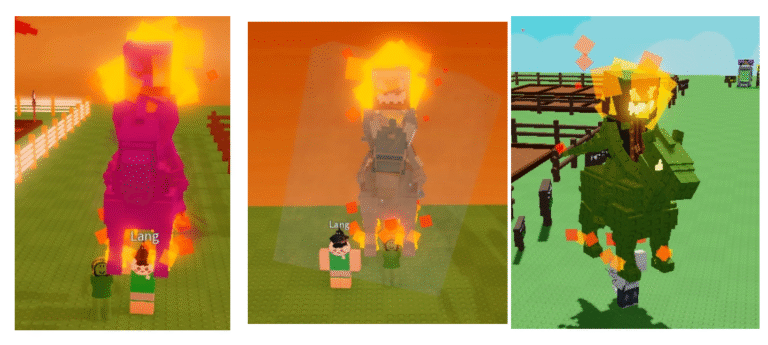
In Grow A Garden, mastering pets isn’t just about collecting the cutest companions—it’s about unlocking the right synergies that turn your garden into a Sheckle-generating machine. Whether you’re just starting or trying to understand how to pair pets for maximum efficiency, this guide breaks down 15 beginner-friendly tips to help you build powerful synergies early in the game.
1. Understand Each Pet’s Passive Skill
In Grow A Garden, every pet comes with a passive skill that activates automatically during gameplay. These skills can range from increasing crop value, boosting currency earnings (Sheckles), reducing action cooldowns, or applying plant mutations.
As a beginner, don’t just look at a pet’s rarity—pay attention to what it actually does. For example, a Rare pet that reduces growth time by 10% might be more useful early on than an Epic pet with a situational bonus. Tap each pet in your collection, read their descriptions, and start thinking in terms of function over rarity. Understanding passives is the first step to building effective synergy.
2. Group Pets by Ability Type
A great habit to form early is grouping pets based on what they do. Even if the game doesn’t let you officially “tag” pets, you can mentally (or manually in a spreadsheet) organize them into the following types:
- Growth Speed Boosters – pets that reduce the time crops take to mature.
- Sheckle Multipliers – pets that increase the amount of in-game currency you earn.
- Cooldown Reducers – pets that shorten the wait time for fertilizer, watering, and other actions.
- Mutation Givers – pets that apply valuable transformations to your plants.
- Utility Helpers – pets that provide extra storage, auto-harvesting, or other quality-of-life boosts.
Having these groups in mind will make it easier to slot in pets that work together rather than just picking your highest rarity options.
3. Focus on a Core Trio First
Instead of trying to level up every pet you own, start by choosing three that form a balanced team. Look for synergy:
- A pet that increases growth speed
- A pet that boosts crop value
- A pet that multiplies Sheckles earned
This trio covers the basic gameplay loop—planting, growing, and selling. Focus your resources (like pet food and evolution items) on these three to get the most value early on. You can expand your lineup later, but starting with a strong core team will help you clear quests, events, and farm currency much faster.
4. Use Mutation Pets for Crop Specialization
Mutation pets are some of the most interesting and profitable in the game. They apply special effects—like "Gold," "Frozen," or "Pollinated"—to crops, which often boost their selling price or provide other benefits.
For beginners, it’s smart to choose one or two reliable crops and consistently use mutation pets on them. For instance, pairing a Dragonfly (Gold mutation) with a high-value crop like Bone Blossom can turn an ordinary harvest into a jackpot. Mutations stack well with other bonuses too, so they form the foundation of advanced synergy builds.
Even if you don’t have top-tier mutation pets yet, start experimenting with the ones you do have—you’ll quickly see the difference in your earnings.
5. Synergize Around Your Playstyle
One of the most overlooked aspects of synergy is you. How often do you play? Are you the type who logs in every 30 minutes or just once or twice a day? Your answer should guide your pet choices.
- If you’re active, use Grow A Garden pets that reward frequent actions—like those that reduce cooldowns, refresh energy faster, or give bonuses after watering or harvesting.
- If you’re more passive, lean into idle-oriented pets that generate Sheckles while offline or extend buff durations so you don’t need to check in constantly.
Matching your pet lineup to your routine is key to maximizing efficiency. There’s no one-size-fits-all team—your play habits are part of the synergy formula too.
6. Watch for Hidden Buff Stacking
Some pets in Grow A Garden provide buffs that appear minor on their own but become extremely powerful when stacked. For example, having two pets that each reduce watering cooldown by 5% may seem small—until you realize the combined effect shortens your action loop significantly over long sessions.
What’s important here is buff type awareness:
- Stackable buffs (like cooldown reductions or Sheckle multipliers) often combine additively, leading to compounding gains.
- Non-stackable buffs (like “once-per-hour” boosts or one-time crop bonuses) may override each other if too similar.
As a beginner, keep an eye on how pets interact—if two effects feel stronger together than alone, you’ve likely discovered a stackable synergy. Document those combos and use them to your advantage in farming rotations or events.
7. Pair Utility Pets with High-Earning Crops
Utility pets don’t always sound exciting—they won’t mutate your crops or double your income outright. But they quietly enhance gameplay efficiency, especially when paired with valuable crops.
Here’s how:
- A pet that auto-collects crops every few minutes ensures you never miss a high-value harvest (like Bone Blossom or Meteor Melon).
- A pet that extends fertilizer duration saves you from constantly restocking and boosts the overall output from expensive fertilizer types.
- Some pets reduce planting costs or refresh tasks faster, letting you farm longer with fewer interruptions.
If you’re growing high-Sheckle crops, these utility pets can be the difference between casual gains and full optimization. Think of them as support units that keep your farming engine running smoothly.
8. Use Elemental Affinities to Your Advantage
Each crop and many pets in Grow A Garden belong to specific elemental types—such as Nature, Fire, Frost, or Earth. What many new players overlook is that matching elemental affinities between pets and crops often results in boosted effects.
For example:
- A Nature-aligned pet paired with a Nature crop might apply bonuses faster or with stronger effect.
- Elemental alignment can sometimes unlock passive synergy boosts, like increased mutation rates or reduced crop decay.
While not every elemental match will be game-changing, experimenting with these pairings is worth it—especially once your garden becomes more diverse. Pay attention to pet descriptions and elemental icons when organizing your team.
9. Upgrade in Sync
It’s tempting to upgrade the “strongest” pets first, but synergy relies on balance, not brute force. Upgrading a mutation pet to Level 10 while leaving its supporting growth booster at Level 2 limits your overall benefit.
Instead, choose a synergistic group of 2–3 pets and upgrade them together. For instance:
- Leveling a pet that applies Gold mutation AND
- Leveling a crop speed booster AND
- Leveling a passive Sheckle multiplier
…can result in far more output than just maxing one.
Synchronized upgrades ensure your pets scale as a team, multiplying their effectiveness. It’s like building a strategy deck in a card game—you want combos, not just raw power.
10. Experiment With Rotational Setups
As you unlock more pets, it becomes important to rotate lineups depending on your goal. There’s no “perfect team” for every situation, but there are better combinations for specific tasks:
- Currency farming: Focus on Sheckle multipliers and growth-speed pets.
- Crop mutation farming: Prioritize mutation givers and utility pets that reduce downtime.
- Event participation: Look for pets with temporary bonuses tied to event mechanics.
Try assigning different pet groups to different tasks or time windows. You might use one team for daytime farming (active play) and another for overnight idle bonuses. With practice, this rotation strategy helps you squeeze more progress from the same time investment.
11. Always Keep a Mutation Pet Active
Even in the early game, mutation pets can provide surprisingly valuable boosts. These pets apply random or specific visual and stat-based mutations to your crops—like Gold, Frozen, Zombified, or Pollinated. While mutations might seem cosmetic at first, many significantly increase the crop’s sale price or crafting value.
Here’s why this matters:
Mutation pets often work passively, so there’s no downside to having one always active in your team. Even when farming low-tier crops, a lucky mutation can turn a basic yield into a big profit. And for high-end crops, mutations multiply value even further.
Think of your mutation pet as a “wild card” that can randomly elevate your entire harvest. Always include at least one in your active rotation—it pays off more often than you’d expect.
12. Don’t Ignore Event-Specific Synergies
Limited-time events in Grow A Garden often introduce new crops, pets, or game rules, and some existing pets get temporary synergy bonuses during those periods. For example, a normally average pet might suddenly double its passive effect during a spring or Halloween event.
To take full advantage:
- Read event patch notes carefully.
- Check for pets in your collection that have event-specific tags or buffs.
- Rotate your active team to include boosted pets—event synergy can outpace regular strategies.
These limited windows can be incredibly rewarding if you tailor your pet lineup accordingly. Even newer players can compete at a high level by aligning with the event mechanics.
13. Track Cooldowns and Buff Timings
Some of the most effective synergies depend not just on what your pets do—but when they do it. Pets with cooldown-based effects (like “boosts crop value every 60 minutes”) require some timing awareness to use optimally.
Here’s how to manage timing:
- Sync effects: Try pairing pets whose cooldowns trigger around the same time—this helps you line up multiple bonuses during harvest.
- Avoid waste: If one pet’s buff lasts 15 minutes and another’s only 3, you might not be using them to their full potential.
- Use timers or in-game reminders to plan around key cooldowns for high-value crops.
Paying attention to timing may sound tedious, but it can double or triple the effectiveness of your synergy setup when done right.
14. Use Pet Houses to Test Synergy Combos
As your collection grows, it becomes harder to know which pets work best together—especially with overlapping effects. That’s where Pet Houses become incredibly useful. They allow you to test out different lineups in a controlled space before committing to long farming sessions.
Tips for testing:
- Set up a small patch of mid-tier crops.
- Rotate in new pet combinations every 15–30 minutes.
- Monitor the Sheckles earned, time taken, and any special bonuses triggered.
After a few sessions, you’ll start to notice patterns—certain pets consistently perform well together. These discoveries form the core of your future farming setups and event strategies.
15. Document Your Best Combinations
This might sound simple, but it’s one of the most powerful habits to develop: keep track of your successful pet combos. You can use screenshots, a notepad, a spreadsheet, or even an in-game journal if one is available.
Things worth recording:
- Pet combinations that yield high Sheckles
- Mutation success rates tied to specific crops
- Cooldown overlaps that maximize productivity
- Event-specific lineups that worked well
Why this matters: as new pets are added and your collection grows, you’ll want to build on proven strategies instead of reinventing them. Your documented combos become a personal synergy database—something most players wish they’d started sooner.



